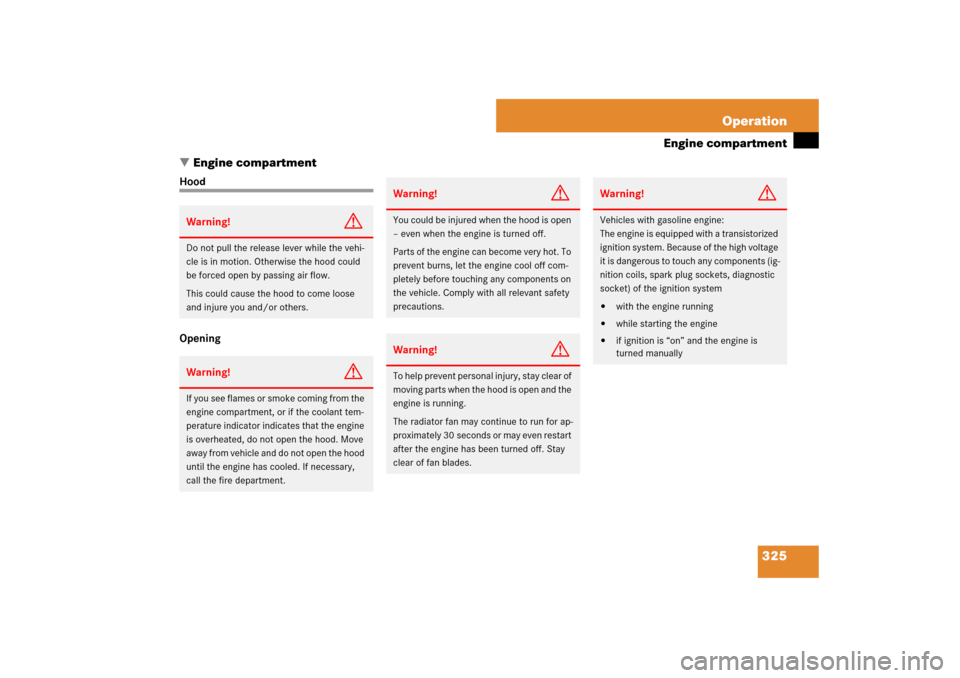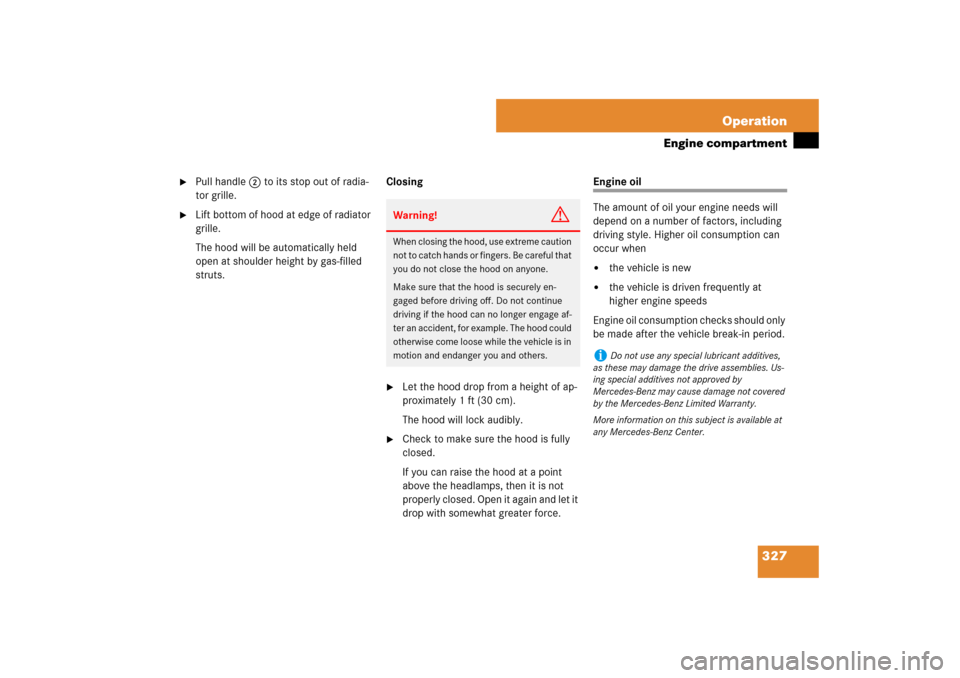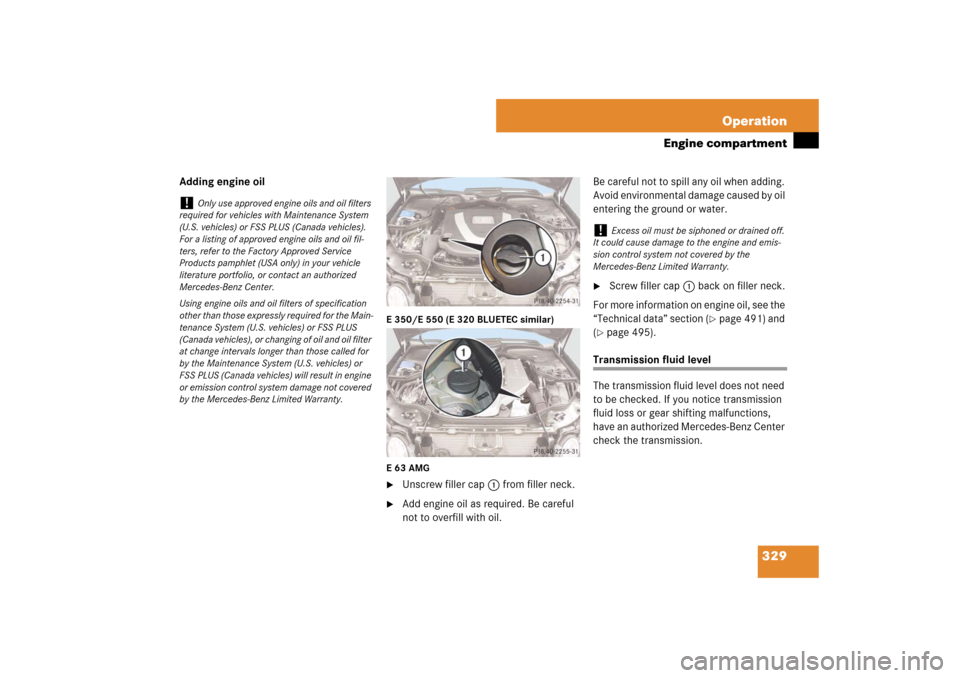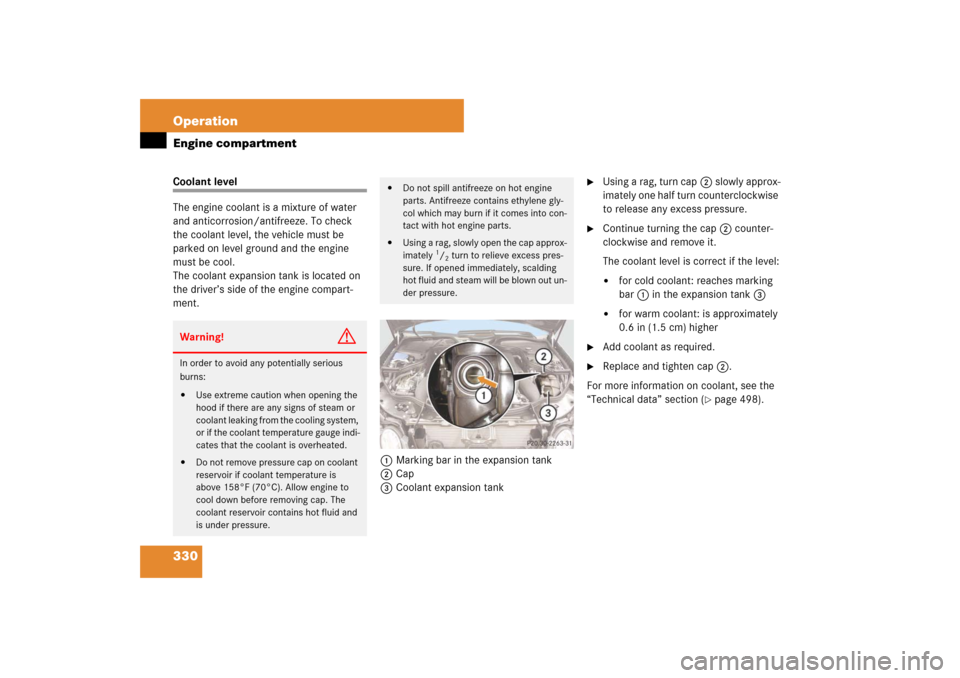Page 324 of 522
323 Operation
At the gas station
Low outside temperatures
(diesel engine)
To prevent malfunctions, diesel fuel with
improved cold flow characteristics is of-
fered in the winter months. Check with
your fuel retailer.
Check regularly and before a long trip
1Windshield washer system and head-
lamp cleaning system*
2Brake fluid
3Coolant level
!
Diesel engine:
The engine is more susceptible to wear and
damage if you use
�
marine diesel fuel
�
heating oil
�
additives
The exhaust aftertreatment device will be
seriously damaged if you use
�
LOW SULFUR DIESEL FUEL
(500 ppm SULFUR MAXIMUM)
�
any other diesel fuel with a sulfur content of
above 15 ppm
The use of such non-approved fuels and/or
special additives is not covered by the
Mercedes-Benz Limited Warranty.
!
Do not fill the tank with gasoline. Do not
blend diesel fuel with gasoline or kerosine. The
fuel system and engine will otherwise be dam-
aged, which is not covered by the
Mercedes-Benz Limited Warranty.
Page 325 of 522

324 OperationAt the gas stationWindshield washer system and
headlamp cleaning system*
For information on refilling the reservoir,
see “Windshield washer system and
headlamp cleaning system*”
(�page 332).
Brake fluid
For information on brake fluid, see “Fuels,
coolants, lubricants etc.” (
�page 491).Coolant
For normal replenishing, use water (pota-
ble water quality). For more information on
coolant, see “Coolant level” (
�page 330)
and see “Fuels, coolants, lubricants etc.”
(
�page 491).
Engine oil level
For more information on engine oil level,
see “Engine oil” (
�page 327).Vehicle lighting
Check function and cleanliness. For more
information on replacing light bulbs, see
“Replacing bulbs” (
�page 443).
For more information, see “Exterior lamp
switch” (
�page 137).
Tire inflation pressure
For more information, see “Checking tire
inflation pressure” (
�page 342).
!
If you find that the brake fluid in the brake
fluid reservoir has fallen to the minimum mark or
below, have the brake system checked for brake
pad thickness and leaks immediately. Notify an
authorized Mercedes-Benz Center immediately.
Do not add brake fluid as this will not solve the
problem. For more information, see “Practical
hints” (�page 383).
Page 326 of 522

325 Operation
Engine compartment
�Engine compartment
Hood
OpeningWarning!
G
Do not pull the release lever while the vehi-
cle is in motion. Otherwise the hood could
be forced open by passing air flow.
This could cause the hood to come loose
and injure you and/or others.Warning!
G
If you see flames or smoke coming from the
engine compartment, or if the coolant tem-
perature indicator indicates that the engine
is overheated, do not open the hood. Move
away from vehicle and do not open the hood
until the engine has cooled. If necessary,
call the fire department.
Warning!
G
You could be injured when the hood is open
– even when the engine is turned off.
Parts of the engine can become very hot. To
prevent burns, let the engine cool off com-
pletely before touching any components on
the vehicle. Comply with all relevant safety
precautions.Warning!
G
To help prevent personal injury, stay clear of
moving parts when the hood is open and the
engine is running.
The radiator fan may continue to run for ap-
proximately 30 seconds or may even restart
after the engine has been turned off. Stay
clear of fan blades.
Warning!
G
Vehicles with gasoline engine:
The engine is equipped with a transistorized
ignition system. Because of the high voltage
it is dangerous to touch any components (ig-
nition coils, spark plug sockets, diagnostic
socket) of the ignition system�
with the engine running
�
while starting the engine
�
if ignition is “on” and the engine is
turned manually
Page 327 of 522
326 OperationEngine compartment
1Release lever�
Pull release lever1.
The hood is unlocked.2Handle for opening the hood
�
Lift the hood slightly.
Handle2 will extend out of the radia-
tor grille.
Warning!
G
Vehicles with diesel engine:
The engine is equipped with a high-voltage
electronic control unit for the injection
system. Because of the high voltage it is
dangerous to touch any components of the
injection system (injectors, electrical wires)�
with the engine running
�
while starting the engine
�
when the ignition is switched on
!
To avoid damage to the windshield wipers or
hood, never open the hood if the wiper arms are
folded forward away from the windshield.
!
To avoid damage to handle2 never pull up
the hood on handle2.
Page 328 of 522

327 Operation
Engine compartment
�
Pull handle2 to its stop out of radia-
tor grille.
�
Lift bottom of hood at edge of radiator
grille.
The hood will be automatically held
open at shoulder height by gas-filled
struts. Closing
�
Let the hood drop from a height of ap-
proximately 1 ft (30 cm).
The hood will lock audibly.
�
Check to make sure the hood is fully
closed.
If you can raise the hood at a point
above the headlamps, then it is not
properly closed. Open it again and let it
drop with somewhat greater force.
Engine oil
The amount of oil your engine needs will
depend on a number of factors, including
driving style. Higher oil consumption can
occur when�
the vehicle is new
�
the vehicle is driven frequently at
higher engine speeds
Engine oil consumption checks should only
be made after the vehicle break-in period.
Warning!
G
When closing the hood, use extreme caution
not to catch hands or fingers. Be careful that
you do not close the hood on anyone.
Make sure that the hood is securely en-
gaged before driving off. Do not continue
driving if the hood can no longer engage af-
ter an accident, for example. The hood could
otherwise come loose while the vehicle is in
motion and endanger you and others.
i
Do not use any special lubricant additives,
as these may damage the drive assemblies. Us-
ing special additives not approved by
Mercedes-Benz may cause damage not covered
by the Mercedes-Benz Limited Warranty.
More information on this subject is available at
any Mercedes-Benz Center.
Page 329 of 522

328 OperationEngine compartmentChecking engine oil level
When checking the oil level�
the vehicle must be parked on level
ground
�
with the engine at operating tempera-
ture, the vehicle must have been sta-
tionary for at least 5 minutes with the
engine turned off
�
with the engine not at operating tem-
perature yet, the vehicle must have
been stationary for at least 5 minutes
with the engine turned off1Oil dipstick
2Upper (max) mark
3Lower (min) mark
To check the engine oil level with the oil
dipstick, do the following:
�
Open the hood (
�page 325).
�
Pull out oil dipstick1.
�
Wipe oil dipstick1 clean.
�
Fully insert oil dipstick1 into the
dipstick guide tube.
�
Pull out oil dipstick1 again after
approximately 3 seconds to obtain ac-
curate reading.
The oil level is correct when it is be-
tween the lower (min) mark3 and
upper (max) mark2 of oil dipstick1.
�
If necessary, add engine oil.
For adding engine oil, see “Adding engine
oil”.
For more information on engine oil, see
“Fuels, coolants, lubricants etc.”
(
�page 491).
For more information on messages in the
multifunction display concerning engine
oil, see the “Practical hints” section
(�page 418).
i
All models (except E 63 AMG):
The filling quantity between the upper and lower
marks on the oil dipstick is approximately
2.1 US qt. (2.0 l).
E63AMG:
The filling quantity between the upper and lower
marks on the oil dipstick is approximately
1.6 US qt. (1.5 l).
Page 330 of 522

329 Operation
Engine compartment
Adding engine oil
E 350/E 550 (E 320 BLUETEC similar)
E63AMG�
Unscrew filler cap1 from filler neck.
�
Add engine oil as required. Be careful
not to overfill with oil.Be careful not to spill any oil when adding.
Avoid environmental damage caused by oil
entering the ground or water.
�
Screw filler cap1 back on filler neck.
For more information on engine oil, see the
“Technical data” section (
�page 491) and
(
�page 495).
Transmission fluid level
The transmission fluid level does not need
to be checked. If you notice transmission
fluid loss or gear shifting malfunctions,
have an authorized Mercedes-Benz Center
check the transmission.
!
Only use approved engine oils and oil filters
required for vehicles with Maintenance System
(U.S. vehicles) or FSS PLUS (Canada vehicles).
For a listing of approved engine oils and oil fil-
ters, refer to the Factory Approved Service
Products pamphlet (USA only) in your vehicle
literature portfolio, or contact an authorized
Mercedes-Benz Center.
Using engine oils and oil filters of specification
other than those expressly required for the Main-
tenance System (U.S. vehicles) or FSS PLUS
(Canada vehicles), or changing of oil and oil filter
at change intervals longer than those called for
by the Maintenance System (U.S. vehicles) or
FSS PLUS (Canada vehicles) will result in engine
or emission control system damage not covered
by the Mercedes-Benz Limited Warranty.
!
Excess oil must be siphoned or drained off.
It could cause damage to the engine and emis-
sion control system not covered by the
Mercedes-Benz Limited Warranty.
Page 331 of 522

330 OperationEngine compartmentCoolant level
The engine coolant is a mixture of water
and anticorrosion/antifreeze. To check
the coolant level, the vehicle must be
parked on level ground and the engine
must be cool.
The coolant expansion tank is located on
the driver’s side of the engine compart-
ment.
1Marking bar in the expansion tank
2Cap
3Coolant expansion tank
�
Using a rag, turn cap2 slowly approx-
imately one half turn counterclockwise
to release any excess pressure.
�
Continue turning the cap2 counter-
clockwise and remove it.
The coolant level is correct if the level:�
for cold coolant: reaches marking
bar1 in the expansion tank3
�
for warm coolant: is approximately
0.6 in (1.5 cm) higher
�
Add coolant as required.
�
Replace and tighten cap2.
For more information on coolant, see the
“Technical data” section (
�page 498).
Warning!
G
In order to avoid any potentially serious
burns:�
Use extreme caution when opening the
hood if there are any signs of steam or
coolant leaking from the cooling system,
or if the coolant temperature gauge indi-
cates that the coolant is overheated.
�
Do not remove pressure cap on coolant
reservoir if coolant temperature is
above 158°F (70°C). Allow engine to
cool down before removing cap. The
coolant reservoir contains hot fluid and
is under pressure.
�
Do not spill antifreeze on hot engine
parts. Antifreeze contains ethylene gly-
col which may burn if it comes into con-
tact with hot engine parts.
�
Using a rag, slowly open the cap approx-
imately
1/2 turn to relieve excess pres-
sure. If opened immediately, scalding
hot fluid and steam will be blown out un-
der pressure.